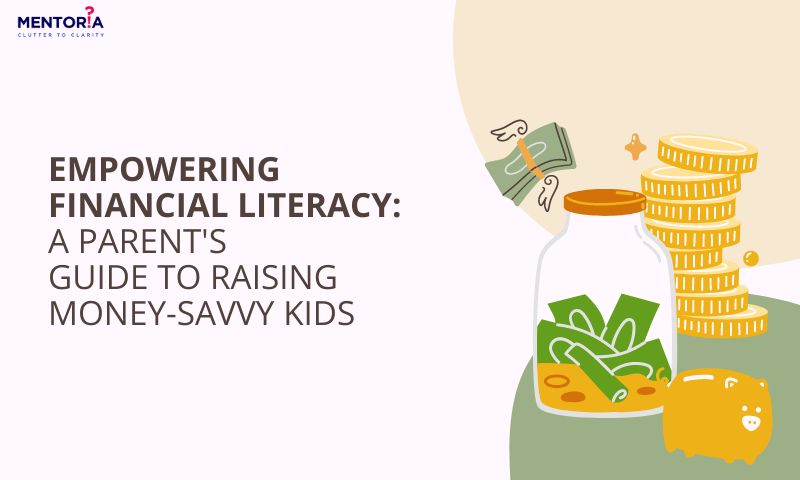Empowering Financial Literacy: A Parent’s Guide to Raising Money-Savvy Kids

As a parent, you have a unique opportunity to equip your children with the knowledge and skills needed to navigate the complex world of finances. Whether it’s understanding the value of saving, making informed spending decisions, or learning the basics of investing, this guide will provide you with practical strategies and insights to set your children on the path to financial success. Our aim is to empower you with actionable tips, age-appropriate lessons, and interactive activities that will make learning about money engaging for your children. We’ll delve into various aspects of financial education, addressing the fundamental concepts in a language that’s easily digestible for both you and your child.
With this guide, you’ll discover how to create a supportive environment that encourages financial discussions, fosters responsible money management, and instils the confidence to make sound financial choices. We believe that by embracing these strategies and cultivating a financially informed household, you’re laying the groundwork for your child’s financial independence and success in adulthood.
Parenting And Early Financial Education
- Begin early and now: The sooner you start teaching your children about money, the better. Even preschoolers can understand fundamental concepts like saving and spending. Show them the ropes using either pretend money or real currency.
- Set a good example: Children absorb all they see and hear like sponges. Allow children to observe your responsible money practises, such as saving, budgeting, and making prudent purchases. Show them how you budget for large purchases and minimise impulsive purchases.
- Begin introducing pocket money and budgeting: Give your children a tiny stipend attached to tasks or duties. Encourage them to budget their money, designating parts for saving, spending, and maybe charitable giving. It’s a hands-on education in money management
- Instil the importance of saving: Set up a piggy bank or a savings jar with your children. Explain that saving a little now can lead to something huge later, such as purchasing an item they’ve had their eye on. It’s a lesson in the power of compound interest and delayed pleasure.
- Make use of real-life scenarios: Take advantage of any opportunity to talk about money. Compare costs, hunt for savings, and include them in decision-making while grocery shopping. It’s an excellent technique to teach real financial skills.
- Establish a bank account: When your child is ready, assist them in opening a bank account. Show them how to deposit money, keep track of the balance, and perhaps earn some interest. It’s like entering the adult world of money!
Basics Of Business And Decision Making
- Foster an entrepreneurial mentality: If your child has a lemonade stand or wants to walk dogs for a charge, encourage them! Entrepreneurial activities teach a strong work ethic as well as how to earn and manage money.
- Discuss the difference between necessities and wants: Assist your children in distinguishing between requirements and wants. Make it an enjoyable game! Ask them to list objects they consider needs and wants while watching television or driving. It assists them in understanding priorities.
- Include them in financial decision-making: Allow your children to join in family finance conversations. Explain why you choose one choice over another and how it affects your family’s finances. It takes the mystery out of decision-making.
- Investigate money games and applications: There are several interactive applications and games available that may make learning about money fun. They may study while having fun with budgeting games and virtual banks.
- Educate them on debt and credit: Explain to them what debt is and how credit works as they become older. In order to minimise interest and penalties, emphasise appropriate credit card usage and the need of paying bills on time.
Importance Of Values And Distress Tolerance
- Talk about generosity and giving back: Involve your children in philanthropic activities to teach them the joy of giving. They might give a portion of their allowance to a worthy charity or volunteer their time.
- Discuss long-term objectives: Introduce the concept of long-term financial objectives, such as purchasing a car, attending university, or travelling, as they mature. Explain how saving and making wise financial decisions may help you achieve your goals.
- Handle financial blunders gracefully: Everyone makes financial mistakes. If your child spends their entire allowance in a single day, talk to them about what went wrong and work with them to devise a strategy to avoid it in the future. It’s all about developing and learning.
- Be honest about your financial situation: Maintain open channels of communication on financial problems. Encourage your children to ask questions and voice their concerns. A positive atmosphere promotes a positive attitude towards money.
- Teach the importance of hard effort: Share personal anecdotes or experiences that demonstrate the worth of hard work and persistence. Explaining the benefits of hard work, whether in your profession or a personal activity, instils a strong work ethic.
Roleplay And Logic Induction
- Encourage customers to browse around: Teach your children to research pricing and features before making a purchase, whether online or in a store. Explain how obtaining the greatest offer might help you save money for other things.
- Introduce them to the concept of saving goals: Assist your youngster in setting attainable savings goals. It may be for a particular gift, a piece of technology, or even a family excursion. Tracking progress towards these objectives is both exhilarating and humbling.
- Act out financial scenarios: Act out real-life scenarios such as going shopping or budgeting for a month. Allow your youngster to play both the buyer and the vendor. It’s a fun method to learn about trades and negotiating.
- Talk about advertising and marketing strategies: Shed insight on how advertisements impact purchasing decisions. Teach them to question if they actually need a product or whether it’s a marketing ploy.
Remember that the process of raising money-savvy children is about teaching good habits, encouraging open communication, and making money learning fun. Let us raise a generation of financially savvy folks!
Bridging The Gap With Mentoria
Mentoria can provide personalised guidance on how to approach financial talks with children, teaching approaches, or coping with specific financial difficulties as a family. We can help to create a network of like-minded parents who are also on the path to developing financially savvy children. This group may exchange experiences, advice, and resources, allowing parents to learn from one another and grow confidence in teaching financial literacy to their children. By utilising our features and services, parents may improve their own financial literacy and learn the tools and information needed to properly teach their children about money management, putting them on the path to financial success and independence.









